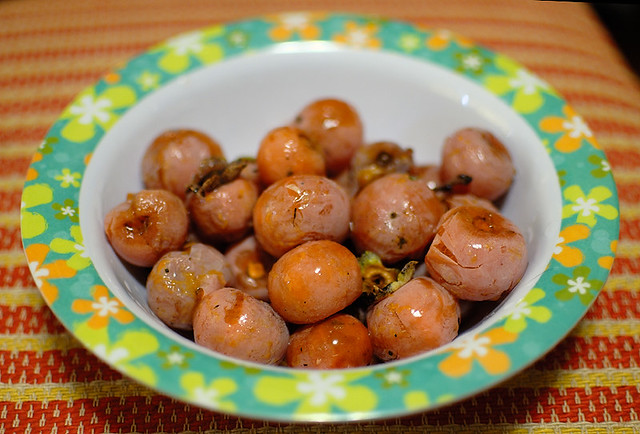ONE OF LIFE’S little joys is finding edibles out in the wild. Being a city boy, my opportunities for learning the difference between poison and pleasure in native flora and fauna were rather limited, but wild persimmons are unmistakable delicacies.

These are American Persimmons, Diospyros virginiana, which are native to the southeastern United States. Saint Louis is near the northern edge of their range.
These ripe fruit are sweet and delicious, with a flavor that I can only describe as tasting like persimmon — although some say it is somewhere in flavor between a date and plum. As its Greek name suggests — God's fire — persimmons of many species were considered a great delicacy since antiquity. The word ‘persimmon’ comes from the Powhatan Algonquin name for this fruit.
These fruit (technically, berries) are not bred to be attractive. Their thin skin is extremely delicate when ripe, and breaks easily, as seen here. Unripe persimmons — of this species — when plucked from trees, are astringent due to high levels of tannins. Rather, these are typically not eaten from the tree (unless they are very soft and ready to fall down), but instead are usually collected off of the ground, which is helpful since mature persimmon trees can be over 100 feet tall.
The method for eating persimmons is simple:
- Find persimmons on the ground.
- Is the fruit soft?
- If yes, pick up, brush off dirt, and eat.
While this is a New World fruit, trees of this species have been grown in Britain for four centuries, although it rarely sets fruit in that locale. Other species of the Diospyros genus can be found in the Old World, and the fruit goes by many names: Japanese persimmon, Sharon fruit, Khormaloo, Date-plum, Black Sapote, Mabolo, Velvet-apple, Shizi, Kaki, Hachiya, Korean Mango, and many others.
Persimmons can be baked into bread and cookies, made into preserves, dried into bars, or made into ice cream. Persimmon pie is similar in look, taste, and texture to another native American favorite, pumpkin pie. A friend, who made a number of persimmon recipes, reports that separating the pulp from the seeds is a lot of work.


I live in Savannah, GA and had a persimmon tree on the property we were renting from. The tree never needed any care and was so loaded with persimmons the branches broke from the weight! Neighbors from all over wanted some and we traded many out for figs, etc. After pureeing, we froze most of the persimmons in bags and use them for pies and bread. I have since moved, but planted one in my new yard right away. I hope to plant more. They are very healthy! The persimmons sold in the grocery stores are awful! Small, not ripe (tannin)...no wonder people don't know about them. I smiled when I saw your post!
ReplyDeleteThere are at least two "pick your own" farms/orchards in Texas County, Missouri (near Rolla and Ft. Leonard Wood) that (according to this website) offer u-pick persimmons:
ReplyDeletehttp://www.pickyourown.org/MO.htm
Not finding any in Illinois or Indiana, however -- which seems odd as my great-aunt who was from southern Indiana loved persimmon pudding and always brought it to our house when she came to visit every year.
Elaine
There are at least two "pick your own" farms/orchards in Texas County, Missouri (near Rolla and Ft. Leonard Wood) that (according to this website) offer u-pick persimmons:
ReplyDeletehttp://www.pickyourown.org/MO.htm
Not finding any in Illinois or Indiana, however -- which seems odd as my great-aunt who was from southern Indiana loved persimmon pudding and always brought it to our house when she came to visit every year.
Elaine